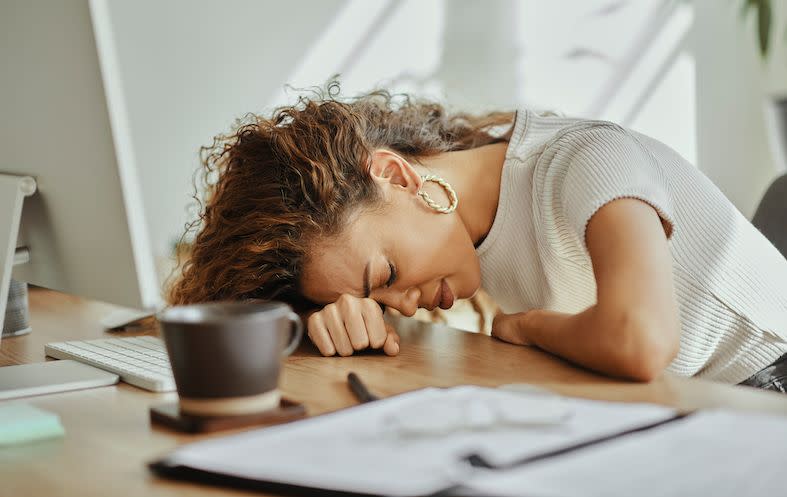The Endometriosis Crisis: How much is your health worth?

Across the UK, thousands of people are in pain, waiting for endometriosis surgery that could give them their lives back. But with the NHS in crisis, many are faced with having to go into debt to pay privately for their treatment.
She’d been battling for 14 years. The pain, sharp twangs of agony that left her bedbound for days, had arrived every month since she was 14. But it was so hard to get an answer as to why she felt this way, never mind a solution.
In her early twenties, doctors told her that it was IBS and the stress of her job. So she quit. Yet the anguish did not alleviate. Her symptoms – severe cramping, heavy blood loss and painful bowel movements – remained. By the time Jessica’s endometriosis was diagnosed at the age of 29, via laparoscopic surgery on the NHS, it was 2020 and the height of the pandemic. The surgeons were able to burn away the endometriosis they could see, spread across her bowels and pelvis, but they weren’t qualified to remove the endometriotic tissue from the root and Jessica was still in pain.
The only answer was seeing a consultant for advice on next steps. The wait? Up to 90 weeks. Instead, she opted to go private; she could be seen in less than a month if she spent £80. The appointment confirmed she needed surgery, for which the wait on the NHS was said to be “a couple of years”. If she went private, she could receive the surgery in a few weeks. But it would cost her... £7,000. Money she simply didn’t have. But her physical symptoms were so severe that it was completely destroying her mental health, so Jessica knew she had to find a way to pay.
I know Jessica’s pain. Not that long ago, in September 2021, I was sobbing in my mum’s lap, clenching and twisting the bed sheets as my ovaries throbbed and agony radiated through my pelvis. Endometriosis, for those of you who don’t know first-hand, is a chronic condition in which tissue similar to that found in the lining of your uterus begins to grow in other parts of your body. Affecting an estimated one in 10 women in the UK, it is the second most common gynaecological condition after uterine fibroids.

I’d been told two months before that my most recent ultrasound had found adhesions and growths on both my ovaries, as well as my uterus. “You need another surgery,” my NHS gynaecologist said casually, as if I hadn’t already trialled a plethora of hormonal interventions and painkillers. As if I hadn’t already had two extensive endometriosis surgeries in five years. And as if I hadn’t been experiencing debilitating pain, heavy bleeding and a lack of control over my body, as well as my life, for well over a decade.
Even worse: I was looking at a wait of over a year and a half, in comparison to ‘just’ nine months when I had my first surgery as a second-year undergraduate student in 2017. Back then, there was a never-ending stream of blood coming out of me during my period and sometimes in between, and the pain was so bad that I was unable to attend lectures, let alone go on nights out or catch up with friends over a coffee. My student years were spent with a hot-water bottle glued to my stomach, as I made hourly trips to the bathroom to change my blood-soaked sanitary pad.
Both times the wait felt impossible. While consecutive surgeries had eased the pain for a short time, it would come back within months, requiring further surgery. Thankfully, my parents were able to pay for private procedures (I’d tried various other treatments on the NHS), but what would have happened if they couldn’t?
The pressure of the pandemic understandably saw millions of ‘non-emergency’ surgeries and appointments cancelled, with a record seven million people in England reportedly waiting for hospital treatment as of August 2022. Among them are hundreds of thousands of those struggling with gynaecological conditions such as endometriosis. The Royal College of Obstetricians and Gynaecologists (RCOG) revealed that gynaecology waiting lists have soared by 59%, with 570,000 women in the UK waiting to be seen. Data collected by leading charity Endometriosis UK found that 17% of patients who had their NHS appointments cancelled or postponed had since sought private endometriosis care due to waiting times.
I’m not sure what’s more worrying – that 17% felt they had no choice but to pay for treatment, or that the other 83% remain on that waiting list, suffering. After all, private healthcare isn’t an option for everyone, with surgery costing between £3,000 and £10,000. A socioeconomic healthcare divide is fast developing and, it seems, women are at the sharp end.
You’re on the (never-ending) list
“It got to the point where I had no autonomy over my body,” Yasmeen Thantrey tells me, of the point when her symptoms were so bad that, as an art student and part-time nanny, she was missing classes and had to be ready to leave at a moment’s notice. “I would have to get taxis when travelling for an extended time. I could be out, then have a flare-up and have to go straight home.”
Despite her dire need, the waiting list to see an NHS gynaecologist was two years. “There was no way I could spend another two months in severe pain, let alone two years,” she says. So she booked an appointment with a private endometriosis specialist, who said she also needed an MRI to assess the extent of the condition. The £700 cost forced Yasmeen into her overdraft.
It was a last-ditch attempt that took her to the very edge of financial safety. Having just begun her master’s degree and with little job security in her part-time work, there was no way she could afford to take on any more debt. Then Yasmeen was told by her gynaecologist that, given the severity of her condition, the surgery she needed would cost thousands. “I didn’t have a full-time job. I was studying, so getting a loan [to afford the private care] just wasn’t an option,” she says.
She joined the NHS waiting list, but due to the Covid backlog, it would be over a year before she could be seen. Yasmeen had no choice but to suffer in silence. “Waiting for surgery is a whole other ball game. That’s horrific in itself,” she says. After a year and a half on the waiting list, she eventually had the treatment and is now recovering.
For Jessica, who lives in Wakefield, the wait was too long. “It was maddening being in that much pain, having to wait to even see a consultant,” she says. Jessica is now paying off £550 a month, with high interest rates, after choosing to get her surgery done privately. “It was the only option that wouldn’t completely destroy my wellbeing,” she says. “I’m an active person and I do triathlons, which is important for my mental health. I would have had to give that up.”
Jessica’s surgeon found that her endometriosis had caused parts of her bowel and ovary to attach to her hip, causing pain when she exercised. Luckily, they were able to free them and give Jessica her quality of life back.
There are certain phrases anyone with endometriosis is used to hearing, such as ‘it’s just period pain’ and ‘it’s part of being a woman’. It takes a staggering seven and a half years, on average, to receive an endometriosis diagnosis, and these old tropes are partly why.
Tori Ford, feminist health researcher at Oxford University and founder of Medical Herstory (an international not-for-profit aiming to eliminate sexism and stigma from healthcare), explains to me why this could be. “Currently and historically, women’s pain is more likely to be dismissed as hysterical, overly emotional, dramatic and untrustworthy in medical settings.” Plus, Ford adds, “Conditions that disproportionately (or differently) affect people who are assigned female at birth are both chronically underfunded and under-researched.” Despite the fact that endometriosis is often seen as a health issue that only impacts the lives of women, it can affect trans and non-binary people, too.
Vasileios Minas, consultant gynaecologist and endometriosis specialist at Ashford & St Peter’s Hospital, agrees. “Society seems to have accepted the concept that women will suffer during their periods. I believe that healthcare professionals are partially responsible for this false perception. It is therefore our role as healthcare professionals – our responsibility and obligation as a society – to stand next to women with endometriosis and advocate for them to receive the care they need.”

But this care is complex, and so funding – and proper training – is essential. “Endometriosis is one of the hardest problems to deal with in gynaecology. Some of these operations can last six hours or longer,” says Dr Minas. “It takes at least five years to train and produce a competent endometriosis surgeon.”
Ultimately though, it all comes down to a reasonable expectation of quality of life, Dr Minas adds. “The reality remains that endometriosis rarely threatens life, as opposed to, say, cancer or cardiovascular disease – conditions that have received a lot more research funding and attention. It threatens quality of life, but rarely life itself. Of course, many, including myself, would argue that having a reasonable quality of life is extremely important and, on some occasions, perhaps as important as life itself.” According to a survey by the RCOG of women waiting for gynaecology care, 80% said their mental health has worsened due to the wait and more than three-quarters (77%) reported that their ability to work or take part in social activities had been negatively impacted.
And while the gender health gap widens, so too does the wealth gap. The same RCOG study showed how much gynaecology waiting lists vary, with the north-west having eight out of the 10 worst-affected Clinical Commissioning Groups (CCGs). The study showed that some of these hardest hit CCGs have waiting lists that are over five times longer than those with the lowest.
Carys Williams, from Bridgend in South Wales, has been fighting her battle since she was 10 years old. Now 29, she spent her teen years and early twenties ‘going back and forth to the hospital’. Carys begged her doctors to do something, but instead they kept sending her home with new forms of contraception to try. “I developed really severe anxiety because it got to the point where I just couldn’t cope any more,” she says.
Carys was able to get herself referred to see a gynaecologist at an endometriosis centre in Cardiff and was put on the waiting list for surgery. But when she asked them how long she’d be waiting for the operation, she was met with a response that shocked her: six years. Carys knew something had to be done so that she could regain control over her life. With the help of her partner, she began to look into going private for the surgery, but when she phoned the hospital to ask for a quote, they told her that the surgery would cost £6,000.
Like Jessica, Carys was unable to afford the surgery outright and decided to go for the finance option, paying £600 a month. But this meant her life plans took a huge hit. “It’s come at such a weird time because my partner and I have been trying to save for a house, like most people in their late twenties. But now we’ve had to move in with my mum.”
Unlike England and Scotland, who between them have 54 NHS-run endometriosis centres, Wales is home to only one centre that is accredited by The British Society for Gynaecological Endoscopy. This means that thousands of women from all over Wales are having to travel long distances just to ensure they get the treatment they need. Unfortunately for Carys, the endometriosis surgery hasn’t completely relieved her pain either and she finds herself struggling. “I’m still taking morphine daily,” she says.
While my symptoms and Jessica’s have, thankfully, eased, there’s no guarantee that surgery will work. Certain forms have been reported to have an impact and improve quality of life, but it varies for each individual. And even if the symptoms are alleviated, there’s always a risk that they could come back at any time. An article in the journal Women’s Health suggested that the recurrence rate of endometriosis could be anywhere from 6% to 67% following surgery. This adds further stress for those who have been forced to choose private treatment, knowing that this is a financial burden they may have to shoulder for the rest of their lives.
A wider problem
With views overlooking Buckingham Palace, the brand-new 184-bed, eight-storey Cleveland Clinic hospital in central London is said to be marking a new era of luxury healthcare in Britain. Then there’s the surge of digital GP platforms, such as Livi, Push Doctor and Babylon, where you can pay £49 to see a GP almost straight away. We’re in the midst of a private healthcare boom and it’s not hard to see why. But what does it mean for us as patients?
The impact on the NHS is still being debated by many people. Some argue that it helps to alleviate the pressure, perhaps reducing lengthy waiting lists; last year, patients paid for 250,000 private treatments that the NHS didn’t have to carry out. Others argue it’s private companies that are playing a big role in the current NHS recruitment crisis, as staff are choosing to head to them instead. While there are many reasons for NHS staffing shortages, the fact is that as of June 2022, there were more than 130,000 unfilled vacancies in secondary care in England – the largest number since June 2019.
Many fear that we’re heading into a dangerous healthcare gap, with top-tier healthcare only accessible to the wealthy. While insurance – either paid for personally or through work – means not everyone will have to resort to their savings or a credit card to fund treatment, 69,000 people in the UK did self-fund their medical treatment in the final three months of last year – a 39% rise on the same period pre-pandemic.
“Funding surgery or other healthcare privately can speed up treatment, or give access to treatment that otherwise wouldn’t be available, so it’s not surprising people may borrow to do this,” says Sue Anderson, head of media at debt charity StepChange. “However, it’s important to remember that the borrowing will still carry the same kinds of risks any other borrowing would. If using credit stretches your finances to the point of not having enough to cover your essentials (food, fuel, household bills, etc), it could leave you vulnerable to problem debt in the future, so try to make sure that it will be affordable. For anyone worried about their finances, or struggling with debt, a charity such as StepChange can offer free and impartial debt advice, tailored to your personal circumstances.”
There are certainly no quick and simple answers for a system that’s battling both underfunding and outdated gender stereotypes, but there is help out there. Endometriosis UK offers great resources, and there’s information on the right about how to get a diagnosis and chase up waiting times. In the meantime? Let’s hope (and vote) for a government that prioritises the NHS and knows that free healthcare is completely meaningless if it takes years of agony to access.
Think you may have endometriosis?
Here are some tips on how to begin your diagnosis journey:
Track your cycle and symptoms - Note how much blood you’re losing on average and how long or regular your periods are, as well as spotting and pain during sex or ovulation.
Be open with your GP - Sharing intimate details may seem a little uncomfortable, but if you think something isn’t right, discuss it with your doctor. Remember, they’ve seen it all before. People often think that endometriosis is a period disorder, but the truth is that endometriosis can occur in any part of your body. Make sure you mention any other symptoms you might have, such as a persistent cough when you’re on your period or frequent urinary tract infections.
If your GP won’t take your concerns seriously... ask them why - Emphasise the impact that these symptoms are having on your life. Tell them what you want. Your GP won’t be able to diagnose you with endometriosis, but they can refer you to a gynaecologist who can investigate further if they think something is wrong.
Chase up with the hospital - If you’re already on the waiting list to see a gynaecologist but it’s taking a long time, chase up the hospital. Ask them exactly how long it will be, so you can get a clear idea. In cases where symptoms or circumstances have worsened, they might be able to expedite your appointment. You can also ask your GP to write to them.
You Might Also Like

 Yahoo News
Yahoo News 